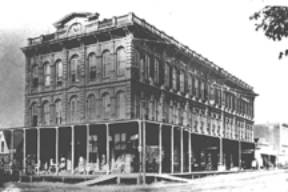|
"Reed Opera House"


The Reed Opera House is the only truly monumental building dating from
the nineteenth century remaining in the center of Oregonís Capital City,
with the exception of the First Methodist Church and Waller Hall on the
Willamette University campus.
Architecturally, it is significant as a choice example of
commercial Italianate design somewhat typical of West Coast building of
its day. G. W. Rhodes, the architect, was also responsible for the
castellated brick masonry State Penitentiary of 1870, a structure no
longer in existence.
Historically, it is significant as Salemís early cultural and social
center. It was a product of the rapid growth the town enjoyed upon
development of the Oregon and California Railroad, which provided (in
addition to the Willamette River) another, faster link to West Coast
markets.
General Cyrus
A. Reed, who built the Opera House, had been Adjutant General of
Oregon during the later part of the Civil War. He was interested in
womenís rights, spiritualism and dramatics. He was a self-taught artist
who painted the scenes for his theater. He built the Opera House
from funds obtained through real estate development. At first, he ran both
the Opera House and the Reed Opera House Hotel. The project proved to be
more costly than planned and he had great difficulty in salvaging his
interests.
From its grand opening on October 9, 1869, with "The Female
Gambler" the Opera House provided a stage for traveling dramatic
troupes, the Salem Dramatic Association, the Salem Musical Union, the
Firemen's Annual New Yearís Ball, gubernatorial inaugurations, political
meetings, community celebrations, and fortnightly dances. Many
lecturers and entertainers, and other visitors to the Capital City found a
public hall and an audience at the Opera House. On April 20, 1900 the
Opera House closed because the Grand Theater Opera House, also in downtown
Salem was more readily accessible from the street level.
The Reed Opera House Hotel opened as a first class operation, but
quickly became a second class institution in competition with the larger
Chemeketa House, later known as the Marion Hotel. On the other hand,
the Opera House Saloon was the best in town around 1893 and was the center
of the city's heaviest gambling.
The 1900 redevelopment on behalf of Joseph Meyers and Sons (later
Millerís Department Store) was a most successful economic venture and
with the addition of Montgomery Ward and J. C. Penney to the street,
Liberty became the retail center, somewhat displacing Commercial Street in
that capacity.
The introduction of larger stores from Portland after World War II,
temporarily ended the vitality of Salem's downtown retail core but close
attention from merchants and city government has sustained its viability.
Today the Reed Opera House serves as a shopping center, a home for several
cafes and restaurants and hosts many community gatherings in its
conference rooms.
Researched and written by Paul Porter and Susan Gibby.
|